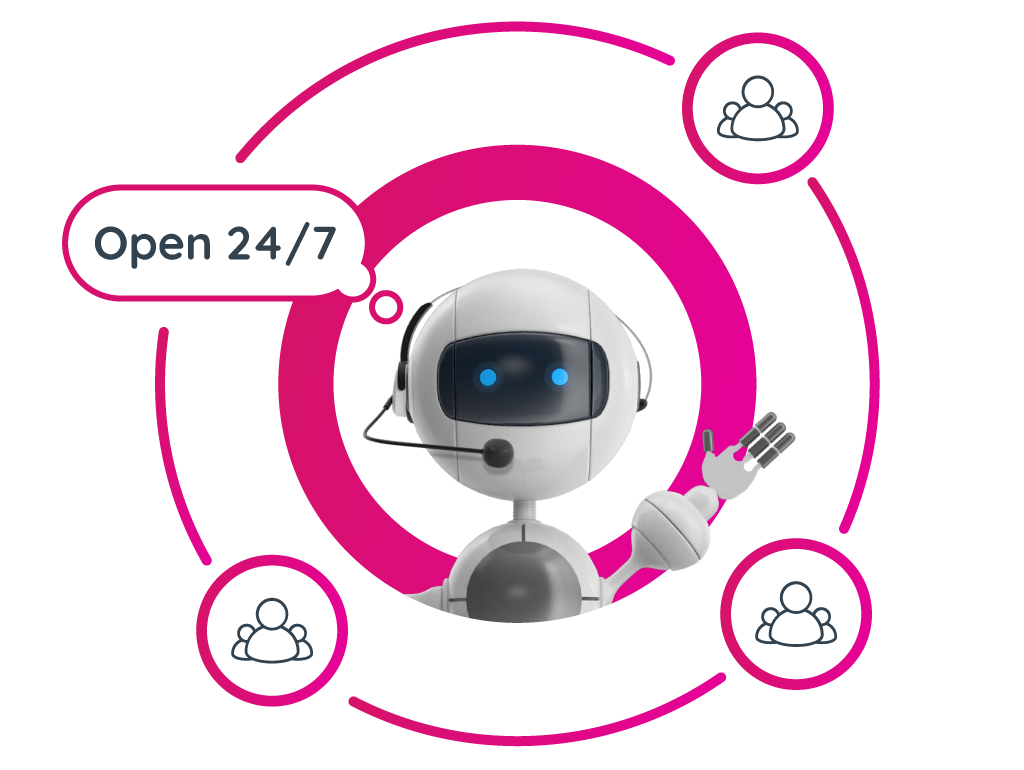Communication
Intelligent Call Centre

An Intelligent Call Centre Solution is a comprehensive system that leverages artificial intelligence (AI) and advanced technologies to enhance the efficiency, effectiveness, and overall performance of call center operations. It combines automated features, intelligent routing, and analytics capabilities to optimize customer interactions and improve agent productivity.
When it comes to delivering superior customer experience, the call center is your frontline. We offer different call center solutions:
- Setup a call center for your business
- Outsourcing call center services to us
- Call center efficiency evaluation and advisory services
Chatbot

A Chatbot solution is an automated conversational agent designed to interact with users through text or speech. It utilizes artificial intelligence (AI) technologies to understand user queries, provide relevant responses, and assist with various tasks. Chatbots are deployed across multiple platforms such as websites, messaging apps, and customer service portals to enhance user experiences, streamline communication, and automate repetitive tasks.
With Chatbot, automating customer service is a breeze. Studies show that, more and more customer interaction were handled without a human. It handles all common questions instantly and around the clock. With integration with our call center solution, you will definitely offer the best in class customer services to your valuable customers.
Sales and Marketing
Benefits of Our Sales and Marketing Solutions:
- Improved Lead Generation: Sales and marketing solutions help businesses attract high-quality leads and nurture them through targeted campaigns, increasing the chances of conversion.
- Enhanced Customer Engagement: These solutions enable businesses to deliver personalized and relevant messages to customers, creating meaningful engagements and building stronger relationships.
- Increased Sales Efficiency: Automation and streamlined processes provided by sales and marketing solutions reduce manual tasks, allowing sales teams to focus on high-value activities and close deals faster.
- Data-Driven Decision Making: With robust analytics and reporting, businesses can gain valuable insights into customer preferences, campaign performance, and sales trends, enabling informed decision-making and continuous optimization.
Lead Generation and Management

Include lead generation tools and techniques to attract potential customers. These solutions employ strategies like content marketing, social media marketing, search engine optimization (SEO), and paid advertising to generate leads. Lead management tools help businesses capture, track, and nurture leads throughout the sales funnel.
Marketing Automation

Marketing automation tools simplify repetitive marketing tasks, such as email marketing, social media posting, and lead nurturing. These solutions enable businesses to automate personalized, targeted messaging at scale, saving time and increasing efficiency.
Analytics and Reporting

Sales and marketing solutions provide robust analytics and reporting capabilities to measure the effectiveness of campaigns, track key performance indicators (KPIs), and gain insights into customer behavior. Data-driven decision-making is crucial for optimizing marketing efforts and improving sales performance.
Sales Enablement

Sales enablement tools provide resources, content, and training to empower sales teams and enhance their productivity. These tools include sales collateral, playbooks, training materials, and content management systems, ensuring that sales representatives have the right information at their fingertips to engage with prospects and close deals.
In summary, sales and marketing solutions provide businesses with the tools and strategies needed to effectively reach and engage their target audience, generate leads, and drive revenue growth. By leveraging technology, automation, and data-driven insights, businesses can optimize their sales and marketing efforts, ultimately leading to increased customer acquisition and retention.
IT Service Solutions
Information Security Consultancy

We provide expert advice and guidance to organizations regarding their information security practices. The main goal of an information security consultant is to help businesses identify and mitigate potential risks and vulnerabilities in their information systems, networks, and data.
Here’s a brief overview of what you can expect from information security consultancy from us:
Risk Assessment: Information security consultants begin by conducting a comprehensive assessment of an organization’s existing security posture. They evaluate the systems, processes, and policies in place to identify vulnerabilities and potential threats. This assessment helps consultants understand the specific security challenges faced by the organization.
Security Strategy and Planning: Based on the findings of the risk assessment and security audits, consultants work with the organization to develop a security strategy and roadmap. They provide recommendations on security technologies, policies, and procedures to enhance the overall security posture and align it with industry best practices and compliance requirements.
Security Awareness and Training: Consultants often conduct security awareness programs and training sessions for employees to educate them about various security threats, social engineering techniques, and best practices for secure behavior. This helps create a security-conscious culture within the organization and reduces the likelihood of human error leading to security incidents.
Ongoing Support: Information security consultancy is not a one-time engagement. Consultants may provide ongoing support to organizations, monitoring security controls, conducting periodic assessments, and staying updated on emerging threats and technologies. This ensures that the organization’s security posture remains effective and adaptive to evolving risks.
Speech-to-text Engine

Here’s an overview of how our speech-to-text engines work:
- Audio Input: The speech-to-text engine takes audio input, which can be recorded speech or live audio captured through a microphone or other audio input devices.
- Acoustic Processing: The audio input is processed acoustically to extract relevant features such as pitch, frequency, and intensity. This step involves techniques like signal processing, noise reduction, and audio normalization to enhance the quality of the audio signal.
- Language Modeling: The engine uses language models to analyze the audio input in the context of the specific language being spoken. Language models are statistical models that represent the probabilities of word sequences in a given language. These models help the system predict and recognize words based on their context.
- Phoneme Recognition: Phonemes are the smallest units of sound in a language. The speech-to-text engine analyzes the audio input to identify and recognize individual phonemes. This process involves comparing the acoustic features with a set of pre-defined phonetic patterns.
- Speech Recognition: Using a combination of acoustic processing, language modeling, and phoneme recognition, the engine applies machine learning algorithms, such as Hidden Markov Models (HMMs) or deep neural networks (DNNs), to convert the audio input into text. These algorithms match the audio features with the most likely corresponding words or phrases.
- Post-processing: After the speech is transcribed into text, post-processing techniques are applied to refine the output. This may include correcting errors, adding punctuation, capitalizing letters, and formatting the text to make it more readable and coherent.
- Output: The final output of the speech-to-text engine is the transcribed text, which can be used for various purposes such as real-time captioning, voice assistants, transcription services, voice commands, or any application where spoken language needs to be converted into written form.
Mobile App Development

Our Mobile apps are developed for various platforms, including iOS (Apple’s operating system) and Android (Google’s operating system), and offer users a wide range of functionalities and services.
Here’s an overview of our mobile app development process:
- Idea and Planning: The first step in mobile app development is to define the app’s purpose, target audience, and desired features. This involves brainstorming ideas, conducting market research, and creating a detailed plan that outlines the app’s goals, functionalities, and user experience.
- Design: Once the app’s concept is established, the design phase begins. This includes creating wireframes and mockups to visualize the app’s user interface (UI) and user experience (UX). Designers focus on creating an intuitive and visually appealing interface that aligns with the app’s branding and usability requirements.
- Development: The development phase involves writing the code that brings the app to life. Developers use programming languages such as Swift or Objective-C for iOS apps and Java or Kotlin for Android apps. They implement the app’s features, integrate APIs (Application Programming Interfaces) for accessing external services, and handle data storage and retrieval.
- Testing: Thorough testing is crucial to ensure the app is functional, stable, and free of bugs or performance issues. Testers use various techniques, including manual testing and automated testing, to identify and fix any defects. This includes checking the app’s compatibility across different devices, screen sizes, and operating system versions.
- Deployment: Once the app is thoroughly tested and deemed ready for release, it is submitted to the respective app stores (such as the Apple App Store or Google Play Store). The submission process involves providing necessary metadata, app descriptions, screenshots, and icons. The app goes through a review process by the app store to ensure it meets their guidelines and requirements.
- Maintenance and Updates: After the app is launched, ongoing maintenance is essential to address any issues, provide updates, and introduce new features. This includes monitoring user feedback, fixing bugs, optimizing performance, and releasing regular updates to enhance the app’s functionality and security.